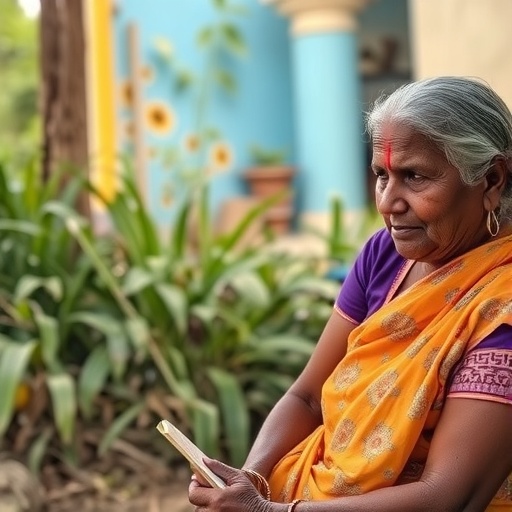In a groundbreaking study published in BMC Geriatrics, researchers SaiHarika et al. examined the prevalence and determinants of anemia within the geriatric population of rural Mangalore. This cross-sectional study sheds light on a critical health issue impacting older adults, particularly in underserved communities where healthcare access can be limited. The research focuses on understanding the multifaceted nature of anemia and its correlation with socio-economic, dietary, and health-related factors.
Anemia, characterized by a deficiency of red blood cells or hemoglobin, can have severe implications for the elderly, leading to diminished quality of life and increased mortality rates. The study emphasizes the urgent need for targeted interventions to improve the health status of older individuals in rural areas. By investigating the prevalence of anemia among this demographic, the researchers aim to inform healthcare policies and practices that can alleviate this condition.
The research team utilized a cross-sectional design, surveying a sample of elderly individuals residing in rural Mangalore. Over 500 participants were recruited, spanning various socio-economic backgrounds. Data collection involved comprehensive interviews, health assessments, and laboratory tests to confirm anemia diagnosis through established medical criteria. The thorough methodology adopted by the researchers ensures the reliability and validity of the findings.
One striking result of the study was the observed prevalence rate of anemia among the participants. The researchers found that nearly 60% of the elderly population surveyed were affected by this condition. This high prevalence rate raises significant concerns regarding the overall health of older adults in rural settings, where factors such as isolation, poverty, and limited access to nutrition exacerbate health issues.
Furthermore, the study reveals that certain demographic factors, such as gender, age, and socio-economic status, play a critical role in the incidence of anemia. For instance, female participants exhibited a higher prevalence of anemia compared to their male counterparts. The reasons for this disparity may be multifactorial, encompassing biological, nutritional, and sociocultural dimensions that impact women’s health differently in rural communities.
Nutritional deficiencies emerged as a prominent contributor to anemia in the study. Many participants reported inadequate dietary intake of essential nutrients, particularly iron, vitamin B12, and folic acid, which are crucial for red blood cell production. The findings highlight the need for community-level nutrition programs aimed at educating older adults about dietary choices and improving access to nutrient-rich foods.
In addition, chronic illnesses such as diabetes, hypertension, and renal diseases were prevalent among participants who suffered from anemia. The study underscores the intertwined nature of chronic diseases and nutritional deficiencies, emphasizing that managing underlying health conditions is vital for preventing and treating anemia effectively. Healthcare providers must adopt a holistic approach to address the complex health needs of the elderly.
The authors of the study advocate for policy changes that prioritize geriatric health in rural areas, including enhanced screening for anemia and broader access to healthcare services. By integrating anemia screening into routine health check-ups for the elderly, healthcare systems can identify at-risk individuals early and initiate appropriate interventions to mitigate the health risks associated with this condition.
Additionally, community engagement is crucial for addressing anemia among the geriatric population. Initiatives that involve local leaders, healthcare professionals, and social workers can create awareness about anemia’s risks and promote better health practices. Empowering communities to take ownership of their health can lead to sustainable improvements in the well-being of elderly individuals.
Education also plays a pivotal role in tackling anemia among older adults. Providing accessible information about nutrition, health management, and healthy lifestyle choices can help bridge the knowledge gap and empower elderly individuals to make informed decisions regarding their health. Educational campaigns can foster a culture of health consciousness, encouraging proactive measures to prevent anemia.
Collaboration between governmental and non-governmental organizations is essential to drive meaningful change. Joint efforts to improve infrastructure, access to healthcare, and nutritional support can significantly impact elderly health outcomes. By prioritizing the needs of the geriatric population, societies can work towards reducing the prevalence of anemia and enhancing the quality of life for older adults.
In conclusion, the study conducted by SaiHarika et al. provides significant insights into the prevalence of anemia among the geriatric population in rural Mangalore. The findings highlight the intricate interplay of various factors contributing to this condition and stress the need for comprehensive strategies to tackle anemia in older adults. As the global population ages, addressing anemia is not only a public health imperative but also a moral obligation to ensure that elderly individuals can lead healthy, fulfilling lives.
This pivotal research acts as a call to action for stakeholders at all levels to prioritize geriatric health and ensure that the vulnerable populations are not overlooked. Future research should continue to explore solutions that can enhance the quality of care for older adults, reducing the burden of anemia and other related health challenges.
Subject of Research: Anemia prevalence among geriatric population in rural Mangalore.
Article Title: Prevalence of anaemia and associated factors among geriatric population from rural Mangalore: a cross-sectional study.
Article References: SaiHarika, B., T, R., Holla, R. et al. Prevalence of anaemia and associated factors among geriatric population from rural Mangalore: a cross-sectional study. BMC Geriatr 25, 929 (2025). https://doi.org/10.1186/s12877-025-06605-1
Image Credits: AI Generated
DOI: https://doi.org/10.1186/s12877-025-06605-1
Keywords: Geriatric health, anemia, rural Mangalore, nutritional deficiencies, chronic illnesses, healthcare access, community engagement, health policy.




